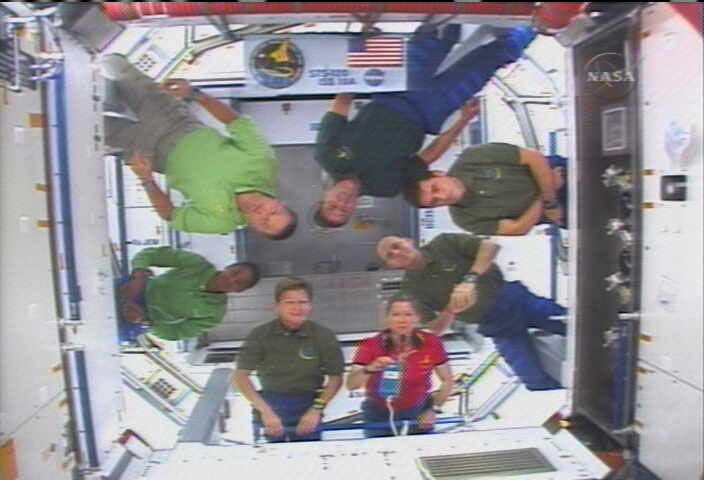Astronauts Open Space Station's New Room

This story was updated at 9:28 a.m. EDT.
HOUSTON — Astronauts the International Space Station (ISS) celebrated the grand opening of their orbital laboratory's latest addition on Saturday to christen the hub-like node dubbed Harmony.
The station's Expedition 16 commander Peggy Whitson and Italian astronaut Paolo Nespoli opened the hatch to the nearly 16-ton Harmony module at 8:24 a.m. EDT (1224 GMT), commemorating the event with a brief ceremony.
"It's a pleasure to be here in this very beautiful piece of hardware," Nespoli said of the Italian-built Harmony node which he and his STS-120 crewmates aboard NASA's shuttle Discovery helped install during a Friday spacewalk.
Nespoli and Whitson wore protective goggles and masks inside the node to guard against any loose debris shaken free during the module delivery to the ISS. They also took air samples after floating into the new orbital room.
Harmony in space
Named by students in a NASA contest, the Harmony node serves as the docking point for European and Japanese laboratories to be installed during future shuttle missions.
"We think Harmony is a very good name for this module because it represents the culmination of a lot of the international partner work," Whitson said during the node's christening.
Get the Space.com Newsletter
Breaking space news, the latest updates on rocket launches, skywatching events and more!
The school bus-sized connecting node was temporarily attached to the space station's Unity module on Friday and will be moved to its permanent position once Discovery leaves the ISS on Nov. 4.
"We're just getting it suitable so we can go in and get the work done," said ISS flight director Holly Ridings late Friday. "But [we'll] not actually do anything permanent in there so that it can be moved again."
Astronauts connected power and data lines to the Harmony module earlier today to power up its internal systems. They will then begin the busy task of replacing valves and removing more than 700 bolts that secured the module's internal components in place during Discovery's Oct. 23 launch.
"At one point, originally in the mission, it was not a requirement for us to go inside,' Discovery's STS-120 mission commander Pamela Melroy said before the spaceflight. "And the crew said, 'No way! We want to go inside!' We were excited about that."
Melroy presented Whitson with a necklace bearing a Harmony module-shaped charm after the node was opened.
The Harmony module increases the internal volume of the ISS by about 2,666 cubic feet (75.4 cubic meters), bringing the station to a total of more than 17,000 cubic feet (481 cubic meters). When complete in 2010, the station will include some 43,000 cubic feet (1,217 cubic meters) of pressurized volume and enough habitable space to rival a five-bedroom home.
Earlier, NASA astronaut Clayton Anderson previewed Harmony's grand opening today with the song "Harmony."
"So that was a little Elton John welcoming her to the fold," said Anderson, who is returning to Earth with Discovery's crew.
An orbital hub
The Harmony node's port side docking berth is reserved for Japan's three-segment Kibo laboratory, while the European Space Agency's Columbus module is slated to be attached to Harmony's starboard side during a December shuttle mission.
NASA European space station partners are counting the days, hours and minutes until Columbus arrives at the station later this year, said ISS deputy program manager Kirk Shireman.
"I think it's prime real estate, because it is at the front and it's at the nexus of three primary pressurized modules," Discovery pilot George Zamka has said of Harmony node before flight.
Installing and outfitting Harmony is one of the major goals for Melroy and her STS-120 crew. During their planned 14-day mission, astronauts will also perform a total of five spacewalks and move a massive solar array segment to the port-most edge of the station's backbone-like main truss.
The Discovery crew awoke at 1:38 a.m. EDT (0538 GMT) today to the song of "Bellissime Stelle" — Italian for "Beautiful Stars" — sung by Andrea Bocelli. The tune was chosen specially for Nespoli.
"We certainly hope that you've had a little bit of time to look out and see the beautiful stars since you've been up there in space," NASA astronaut Shannon Lucid radioed Nespoli from Mission Control here at the Johnson Space Center.
"Yes, stars a really beautiful and from up here they're even more beautiful," Nespoli said. "Thank you to everybody who made this possible. I really appreciate it."
NASA is broadcasting Discovery's STS-120 launch and mission operations live on NASA TV. Click here for mission updates and NASA TV from SPACE.com.
Join our Space Forums to keep talking space on the latest missions, night sky and more! And if you have a news tip, correction or comment, let us know at: community@space.com.

Tariq is the Editor-in-Chief of Space.com and joined the team in 2001, first as an intern and staff writer, and later as an editor. He covers human spaceflight, exploration and space science, as well as skywatching and entertainment. He became Space.com's Managing Editor in 2009 and Editor-in-Chief in 2019. Before joining Space.com, Tariq was a staff reporter for The Los Angeles Times covering education and city beats in La Habra, Fullerton and Huntington Beach. In October 2022, Tariq received the Harry Kolcum Award for excellence in space reporting from the National Space Club Florida Committee. He is also an Eagle Scout (yes, he has the Space Exploration merit badge) and went to Space Camp four times as a kid and a fifth time as an adult. He has journalism degrees from the University of Southern California and New York University. You can find Tariq at Space.com and as the co-host to the This Week In Space podcast with space historian Rod Pyle on the TWiT network. To see his latest project, you can follow Tariq on Twitter @tariqjmalik.








